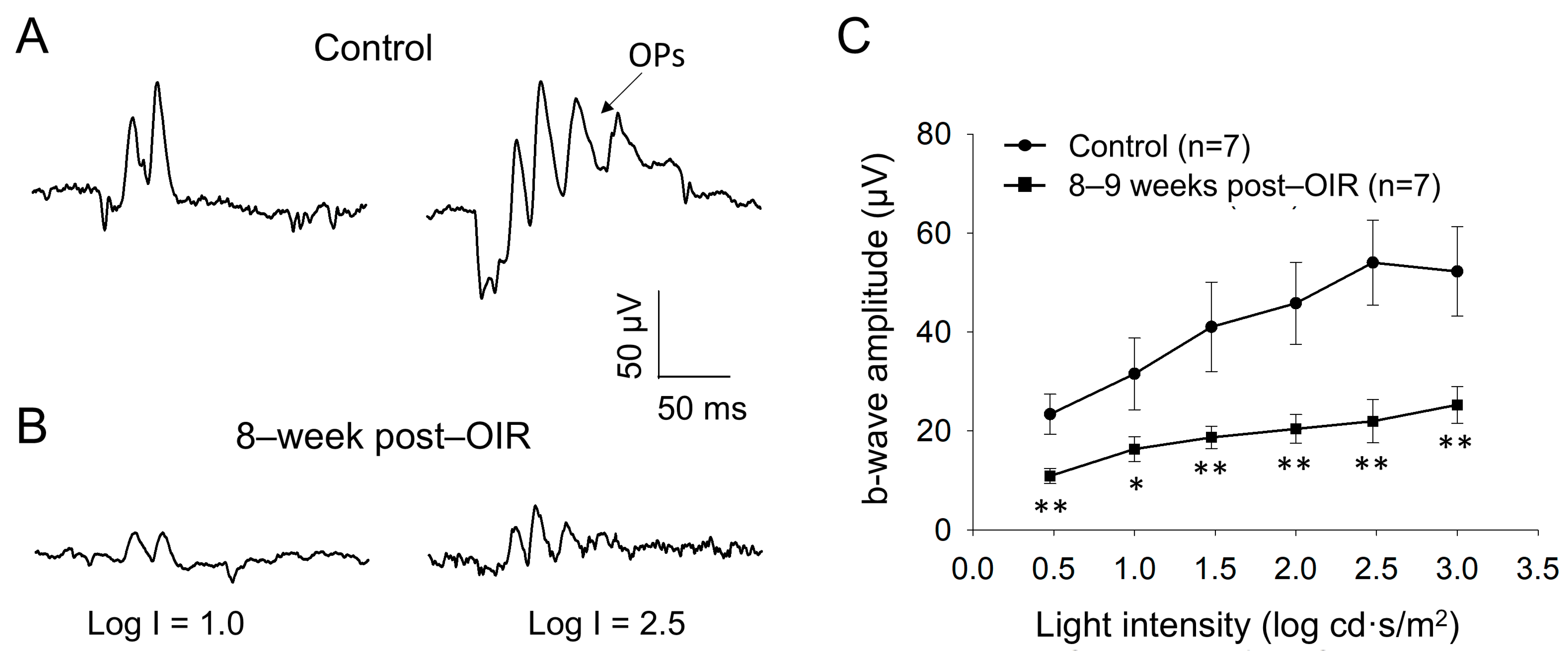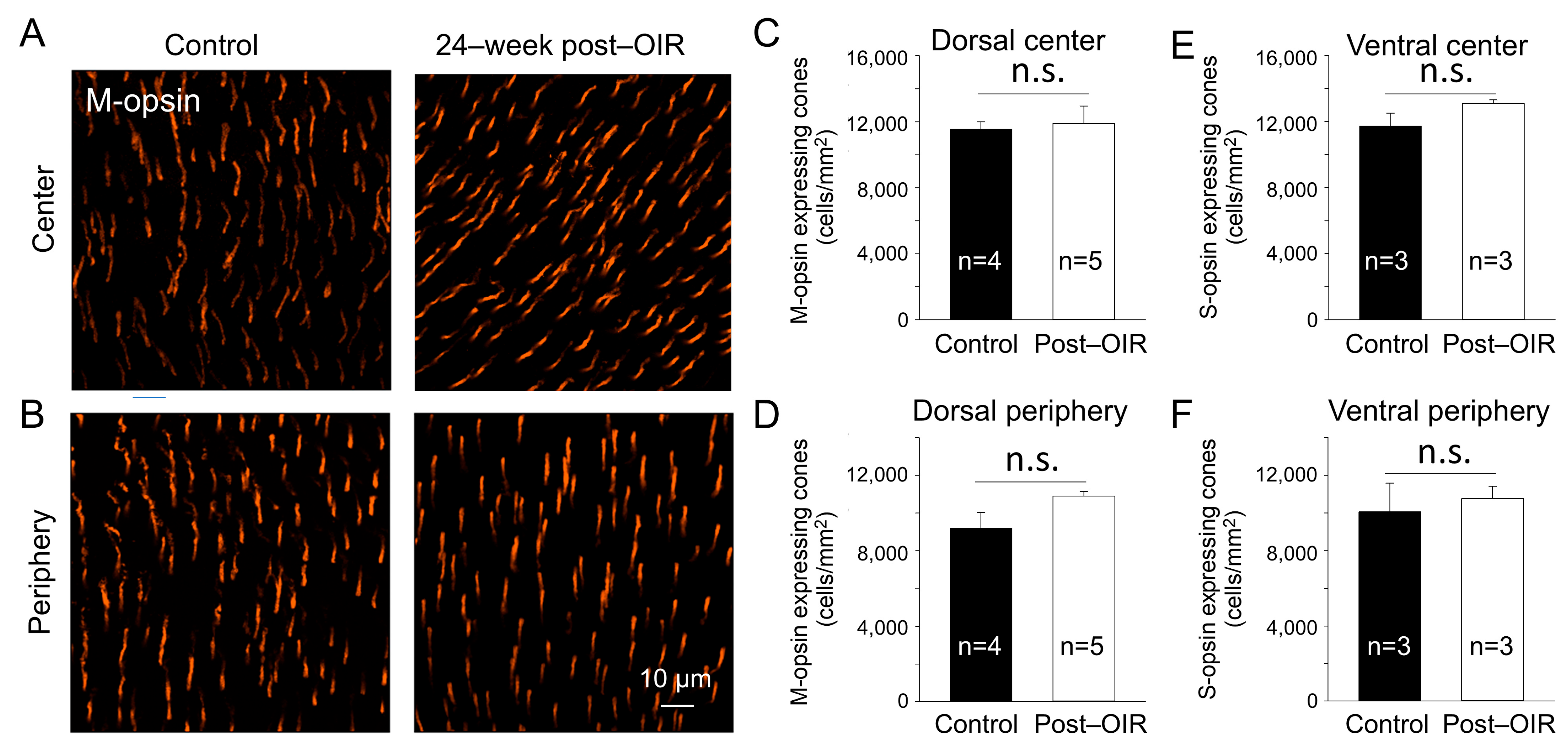Long–Term Impairment of Retinal Ganglion Cell Function After Oxygen–Induced Retinopathy
Abstract
1. Introduction
2. Materials and Methods
2.1. Animals
2.2. OIR Mouse Model
2.3. In Vivo ERG and PERG
2.4. Ex Vivo ERG
2.5. Immunohistochemistry
2.6. Imaging and Analysis
2.7. Statistical Analysis
3. Results
3.1. The P1–N2 Amplitude of the PERG Was Attenuated in Long–Term Post–OIR Mice

3.2. The Density of RGCs Remains Unchanged in Long–Term Post–OIR
3.3. Light–Adapted ERG b–Waves Are Attenuated in Long–Term Post–OIR
3.4. Ex Vivo ERG a–Waves Are Decreased Under Long–Term Post–OIR
3.5. The Density of M–Opsin–Expressing Cones Remains Unchanged in Long–Term Post–OIR
3.6. Long–Term Post–OIR Alters Scotopic b–Waves but Not a–Waves In Vivo and Ex Vivo
4. Discussion
4.1. Evaluation of Visual Function with Multiple ERG Approaches
4.2. Functional Impairment of RGCs in Post–OIR
4.3. The Contribution of the Cone Pathway to the Impairment of RGCs
4.4. Possible Contribution of the Rod Pathway to Dysfunction of RGCs
5. Conclusions
Author Contributions
Funding
Institutional Review Board Statement
Informed Consent Statement
Data Availability Statement
Acknowledgments
Conflicts of Interest
Abbreviations
| ROP | Retinopathy of prematurity |
| OIR | Oxygen–induced retinopathy |
| ERG | Electroretinogram |
| PERG | Pattern electroretinogram |
| RGC | Retinal ganglion cell |
| VEGF | Vascular endothelial growth factor |
| L–AP4 | L–(+)–2–Amino–4–phosphonobutyric acid |
| RPBMS | RNA binding protein with multiple splicing |
| OPs | Oscillatory potentials |
References
- Bishnoi, K.; Prasad, R.; Upadhyay, T.; Mathurkar, S. A Narrative Review on Managing Retinopathy of Prematurity: Insights Into Pathogenesis, Screening, and Treatment Strategies. Cureus 2024, 16, e56168. [Google Scholar] [CrossRef] [PubMed]
- Diggikar, S.; Gurumoorthy, P.; Trif, P.; Mudura, D.; Nagesh, N.K.; Galis, R.; Vinekar, A.; Kramer, B.W. Retinopathy of prematurity and neurodevelopmental outcomes in preterm infants: A systematic review and meta–analysis. Front. Pediatr. 2023, 11, 1055813. [Google Scholar] [CrossRef] [PubMed]
- Smith, L.E.; Wesolowski, E.; McLellan, A.; Kostyk, S.K.; D’Amato, R.; Sullivan, R.; D’Amore, P.A. Oxygen–induced retinopathy in the mouse. Investig. Ophthalmol. Vis. Sci. 1994, 35, 101–111. [Google Scholar]
- Ashton, N.; Ward, B.; Serpell, G. Effect of oxygen on developing retinal vessels with particular reference to the problem of retrolental fibroplasia. Br. J. Ophthalmol. 1954, 38, 397–432. [Google Scholar] [CrossRef] [PubMed]
- Penn, J.S.; Tolman, B.L.; Henry, M.M. Oxygen–induced retinopathy in the rat: Relationship of retinal nonperfusion to subsequent neovascularization. Investig. Ophthalmol. Vis. Sci. 1994, 35, 3429–3435. [Google Scholar]
- McLeod, D.S.; Brownstein, R.; Lutty, G.A. Vaso–obliteration in the canine model of oxygen–induced retinopathy. Investig. Ophthalmol. Vis. Sci. 1996, 37, 300–311. [Google Scholar]
- Rydell–Tormanen, K.; Johnson, J.R. The Applicability of Mouse Models to the Study of Human Disease. Methods Mol. Biol. 2019, 1940, 3–22. [Google Scholar] [CrossRef]
- Vessey, K.A.; Wilkinson–Berka, J.L.; Fletcher, E.L. Characterization of retinal function and glial cell response in a mouse model of oxygen–induced retinopathy. J. Comp. Neurol. 2011, 519, 506–527. [Google Scholar] [CrossRef]
- Hatzopoulos, K.M.; Vessey, K.A.; Wilkinson–Berka, J.L.; Fletcher, E.L. The vasoneuronal effects of AT1 receptor blockade in a rat model of retinopathy of prematurity. Investig. Ophthalmol. Vis. Sci. 2014, 55, 3957–3970. [Google Scholar] [CrossRef]
- Mezu–Ndubuisi, O.J.; Macke, E.L.; Kalavacherla, R.; Nwaba, A.A.; Suscha, A.; Zaitoun, I.S.; Ikeda, A.; Sheibani, N. Long–term evaluation of retinal morphology and function in a mouse model of oxygen–induced retinopathy. Mol. Vis. 2020, 26, 257–276. [Google Scholar]
- Nakamura, S.; Imai, S.; Ogishima, H.; Tsuruma, K.; Shimazawa, M.; Hara, H. Morphological and functional changes in the retina after chronic oxygen–induced retinopathy. PLoS ONE 2012, 7, e32167. [Google Scholar] [CrossRef] [PubMed]
- Porciatti, V. Electrophysiological assessment of retinal ganglion cell function. Exp. Eye Res. 2015, 141, 164–170. [Google Scholar] [CrossRef] [PubMed]
- Luo, X.; Frishman, L.J. Retinal pathway origins of the pattern electroretinogram (PERG). Investig. Ophthalmol. Vis. Sci. 2011, 52, 8571–8584. [Google Scholar] [CrossRef]
- Miura, G.; Wang, M.H.; Ivers, K.M.; Frishman, L.J. Retinal pathway origins of the pattern ERG of the mouse. Exp. Eye Res. 2009, 89, 49–62. [Google Scholar] [CrossRef] [PubMed]
- Mehdi, M.K.; Sage–Ciocca, D.; Challet, E.; Malan, A.; Hicks, D. Oxygen–induced retinopathy induces short–term glial stress and long–term impairment of photoentrainment in mice. Graefes. Arch. Clin. Exp. Ophthalmol. 2014, 252, 595–608. [Google Scholar] [CrossRef]
- Spix, N.J.; Liu, L.L.; Zhang, Z.; Hohlbein, J.P.; Prigge, C.L.; Chintala, S.; Ribelayga, C.P.; Zhang, D.Q. Vulnerability of Dopaminergic Amacrine Cells to Chronic Ischemia in a Mouse Model of Oxygen–Induced Retinopathy. Investig. Ophthalmol. Vis. Sci. 2016, 57, 3047–3057. [Google Scholar] [CrossRef][Green Version]
- Zhang, N.; Favazza, T.L.; Baglieri, A.M.; Benador, I.Y.; Noonan, E.R.; Fulton, A.B.; Hansen, R.M.; Iuvone, P.M.; Akula, J.D. The rat with oxygen–induced retinopathy is myopic with low retinal dopamine. Investig. Ophthalmol. Vis. Sci. 2013, 54, 8275–8284. [Google Scholar] [CrossRef][Green Version]
- Rojo Arias, J.E.; Economopoulou, M.; Juarez Lopez, D.A.; Kurzbach, A.; Au Yeung, K.H.; Englmaier, V.; Merdausl, M.; Schaarschmidt, M.; Ader, M.; Morawietz, H.; et al. VEGF–Trap is a potent modulator of vasoregenerative responses and protects dopaminergic amacrine network integrity in degenerative ischemic neovascular retinopathy. J. Neurochem. 2020, 153, 390–412. [Google Scholar] [CrossRef]
- Dailey, W.A.; Drenser, K.A.; Wong, S.C.; Cheng, M.; Vercellone, J.; Roumayah, K.K.; Feeney, E.V.; Deshpande, M.; Guzman, A.E.; Trese, M.; et al. Norrin treatment improves ganglion cell survival in an oxygen–induced retinopathy model of retinal ischemia. Exp. Eye Res. 2017, 164, 129–138. [Google Scholar] [CrossRef]
- Cavanaugh, B.L.; Milstein, M.L.; Boucher, R.C.; Tan, S.X.; Hanna, M.W.; Seidel, A.; Frederiksen, R.; Saunders, T.L.; Sampath, A.P.; Mitton, K.P.; et al. A new mouse model for PRPH2 pattern dystrophy exhibits functional compensation prior and subsequent to retinal degeneration. Hum. Mol. Genet. 2024, 33, 1916–1928. [Google Scholar] [CrossRef]
- Slaughter, M.M.; Miller, R.F. 2–amino–4–phosphonobutyric acid: A new pharmacological tool for retina research. Science 1981, 211, 182–185. [Google Scholar] [CrossRef] [PubMed]
- Stabio, M.E.; Sondereker, K.B.; Haghgou, S.D.; Day, B.L.; Chidsey, B.; Sabbah, S.; Renna, J.M. A novel map of the mouse eye for orienting retinal topography in anatomical space. J. Comp. Neurol. 2018, 526, 1749–1759. [Google Scholar] [CrossRef] [PubMed]
- Haverkamp, S.; Wassle, H.; Duebel, J.; Kuner, T.; Augustine, G.J.; Feng, G.; Euler, T. The primordial, blue–cone color system of the mouse retina. J. Neurosci. 2005, 25, 5438–5445. [Google Scholar] [CrossRef] [PubMed]
- Applebury, M.L.; Antoch, M.P.; Baxter, L.C.; Chun, L.L.; Falk, J.D.; Farhangfar, F.; Kage, K.; Krzystolik, M.G.; Lyass, L.A.; Robbins, J.T. The murine cone photoreceptor: A single cone type expresses both S and M opsins with retinal spatial patterning. Neuron 2000, 27, 513–523. [Google Scholar] [CrossRef]
- Nadal–Nicolas, F.M.; Kunze, V.P.; Ball, J.M.; Peng, B.T.; Krishnan, A.; Zhou, G.; Dong, L.; Li, W. True S–cones are concentrated in the ventral mouse retina and wired for color detection in the upper visual field. Elife 2020, 9, e56840. [Google Scholar] [CrossRef]
- Ohtoshi, A.; Wang, S.W.; Maeda, H.; Saszik, S.M.; Frishman, L.J.; Klein, W.H.; Behringer, R.R. Regulation of retinal cone bipolar cell differentiation and photopic vision by the CVC homeobox gene Vsx1. Curr. Biol. 2004, 14, 530–536. [Google Scholar] [CrossRef]
- Shirato, S.; Maeda, H.; Miura, G.; Frishman, L.J. Postreceptoral contributions to the light–adapted ERG of mice lacking b–waves. Exp. Eye Res. 2008, 86, 914–928. [Google Scholar] [CrossRef]
- Sharma, S.; Ball, S.L.; Peachey, N.S. Pharmacological studies of the mouse cone electroretinogram. Vis. Neurosci. 2005, 22, 631–636. [Google Scholar] [CrossRef]
- Liao, F.; Liu, H.; Milla–Navarro, S.; Villa, P.; Germain, F. Origin of Retinal Oscillatory Potentials in the Mouse, a Tool to Specifically Locate Retinal Damage. Int. J. Mol. Sci. 2023, 24, 3126. [Google Scholar] [CrossRef]
- Lyubarsky, A.L.; Falsini, B.; Pennesi, M.E.; Valentini, P.; Pugh, E.N., Jr. UV–and midwave–sensitive cone–driven retinal responses of the mouse: A possible phenotype for coexpression of cone photopigments. J. Neurosci. 1999, 19, 442–455. [Google Scholar] [CrossRef]
- Miralles de Imperial–Ollero, J.A.; Gallego–Ortega, A.; Norte–Munoz, M.; Di Pierdomenico, J.; Valiente–Soriano, F.J.; Vidal–Sanz, M. An in vivo model of focal light emitting diode–induced cone photoreceptor phototoxicity in adult pigmented mice: Protection with bFGF. Exp. Eye Res. 2021, 211, 108746. [Google Scholar] [CrossRef] [PubMed]
- Perlman, I.; Normann, R.A. Light adaptation and sensitivity controlling mechanisms in vertebrate photoreceptors. Prog. Retin Eye Res. 1998, 17, 523–563. [Google Scholar] [CrossRef] [PubMed]
- Creel, D.J. The Electroretinogram and Electro–oculogram: Clinical Applications. In Webvision: The Organization of the Retina and Visual System; Kolb, H., Fernandez, E., Jones, B., Nelson, R., Eds.; Publisher: Salt Lake City, UT, USA, 1995. [Google Scholar]
- Liu, P.K.; Huang, W.C.; Wang, N.K. Electroretinogram (ERG) to Evaluate the Retina Using Mouse Models. Methods Mol. Biol. 2023, 2560, 217–227. [Google Scholar] [CrossRef] [PubMed]
- Vinberg, F.; Kolesnikov, A.V.; Kefalov, V.J. Ex vivo ERG analysis of photoreceptors using an in vivo ERG system. Vis. Res. 2014, 101, 108–117. [Google Scholar] [CrossRef]
- Bonezzi, P.J.; Tarchick, M.J.; Renna, J.M. Ex vivo electroretinograms made easy: Performing ERGs using 3D printed components. J. Physiol. 2020, 598, 4821–4842. [Google Scholar] [CrossRef]
- Becker, S.; Carroll, L.S.; Vinberg, F. Rod phototransduction and light signal transmission during type 2 diabetes. BMJ Open Diabetes Res. Care 2020, 8, 1. [Google Scholar] [CrossRef]
- Jackson, C.R.; Ruan, G.X.; Aseem, F.; Abey, J.; Gamble, K.; Stanwood, G.; Palmiter, R.D.; Iuvone, P.M.; McMahon, D.G. Retinal dopamine mediates multiple dimensions of light–adapted vision. J. Neurosci. 2012, 32, 9359–9368. [Google Scholar] [CrossRef]
- Lin, B.; Masland, R.H.; Strettoi, E. Remodeling of cone photoreceptor cells after rod degeneration in rd mice. Exp. Eye Res. 2009, 88, 589–599. [Google Scholar] [CrossRef]





Disclaimer/Publisher’s Note: The statements, opinions and data contained in all publications are solely those of the individual author(s) and contributor(s) and not of MDPI and/or the editor(s). MDPI and/or the editor(s) disclaim responsibility for any injury to people or property resulting from any ideas, methods, instructions or products referred to in the content. |
© 2025 by the authors. Licensee MDPI, Basel, Switzerland. This article is an open access article distributed under the terms and conditions of the Creative Commons Attribution (CC BY) license (https://creativecommons.org/licenses/by/4.0/).
Share and Cite
Schmitz, A.M.; Bumbaru, S.M.; Fakhouri, L.S.; Zhang, D.-Q. Long–Term Impairment of Retinal Ganglion Cell Function After Oxygen–Induced Retinopathy. Cells 2025, 14, 512. https://doi.org/10.3390/cells14070512
Schmitz AM, Bumbaru SM, Fakhouri LS, Zhang D-Q. Long–Term Impairment of Retinal Ganglion Cell Function After Oxygen–Induced Retinopathy. Cells. 2025; 14(7):512. https://doi.org/10.3390/cells14070512
Chicago/Turabian StyleSchmitz, Adam M., Stephanie M. Bumbaru, Laith S. Fakhouri, and Dao-Qi Zhang. 2025. "Long–Term Impairment of Retinal Ganglion Cell Function After Oxygen–Induced Retinopathy" Cells 14, no. 7: 512. https://doi.org/10.3390/cells14070512
APA StyleSchmitz, A. M., Bumbaru, S. M., Fakhouri, L. S., & Zhang, D.-Q. (2025). Long–Term Impairment of Retinal Ganglion Cell Function After Oxygen–Induced Retinopathy. Cells, 14(7), 512. https://doi.org/10.3390/cells14070512




